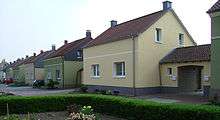Tract housing


.jpg)
Tract housing is a type of housing development in which multiple similar homes are built on a tract of land which is subdivided into individual small lots. Tract housing developments are found in world suburb developments that were modeled on the "Levittown" concept and sometimes encompass large areas of dozens of square miles.
Tract housing development makes use of few architectural designs, and labor costs are reduced because workers need to learn the skills and movements of constructing only those designs rather than repeat the learning curve. In addition, as all homes in the development will be built at the same time, the cost of purchasing and transporting building supplies may be reduced due to economies of scale. Components such as roof trusses, plumbing trees, and stair systems are often prefabricated in factories and installed on-site. This allows builders to offer lower prices, which in turn can make homes affordable to a larger percentage of the population.
Early tract homes were often identical, but many tracts since the late 20th century have several designs and other variations in footprint, roof form, and materials, along with options such as garage bays, for a diverse appearance.
The creation of a "utility side" of the house, often on an alley with common drop locations from the street utilities, reduces both cost and visual clutter, with the opposite side more pleasing in appearance. As with other construction, such reversal may take advantage of beneficial orientation relative to sun, wind, and shade.
The concept of tract housing is occasionally mocked in American popular culture as the basis of suburbia; a notable example is the song "Little Boxes" by Malvina Reynolds. Nonetheless, the use of tract housing in new American suburban residential development remains popular.
Housing colonies
In Europe, the majority of subdivided landstrips are built in the type of row housing development areas. The model of tract housing had been used widely in the history of land reclamation in the 17th to 19th century, especially in the Netherlands and inner-European (former) bogs. Modern tract housing had been used for company towns in the 19th to 20th century, especially in the areas of coal mining which attracted a large number of workers. A tract housing area of this type is colloquially known in German as a "(zechen)kolonie"(de), and in Flemish Dutch and French as a "cité"(nl)/(fr) or "coron"(fr).
See also
| Wikimedia Commons has media related to Tract housing. |
| ||||||||||||||||||||||||||||||
